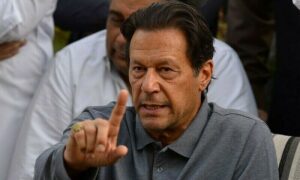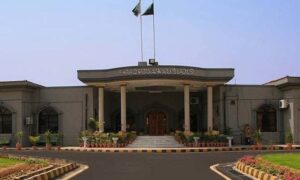The banker-turned-finance minister faces the difficult task of managing the national kitty and steering the country out of its incessant economic crisis.
Muhammad Aurangzeb, a former chief executive of Habib Bank Limited (HBL) with extensive experience in the financial sector, has taken the reins as Pakistan’s new finance minister.
He inherits a daunting economic landscape, grappling with intertwined issues like inflation, unemployment, and significant budget and current account deficits.
A note by Topline Securities stated that the investors were keen on seeing how he performs, as the former banker is hailed as a “solid finance guy” through and through.
But what are the challenges he faces, in the short and long term? Dawn.com spoke to analysts to get some answers.
Negotiating with the IMF
The finance minister definitely knows his first immediate challenge. He laid out his agenda in a single sentence: to focus on the implementation of much-needed reforms and secure a new deal with the IMF.
“No debates, no waste of time — just a steadfast commitment to implementation,” he said while interacting with reporters right after being sworn in. Yesterday, in his first formal media interaction as a minister, he indicated negotiating a “longer and larger” economic bailout package with the IMF.
Khurram Husain, a business and economic journalist, says that the newly appointed finance minister will face the herculean task of “securing the last IMF tranche of the current programme as it comes to an end in April and then negotiating a new one immediately after in the coming months”.
According to macroeconomist Ammar H. Khan, the need for the IMF programme is tied to the country trying to avoid a current account crisis.
“The first challenge the finance minister would have to overcome is essentially closing the programme so the country can move towards macroeconomic stability,” he says.
Ali Farid Khwaja, chairman of KTrade Securities, notes the first short-term step the finance minister would have to take on is delivery on economic reforms to ensure the IMF’s support to avoid a sovereign default, and to ensure that the “global markets believe that he can deliver on IMF reforms”.
Amreen Soorani, head of research at JS Global, states that the new finance minister “faces two critical, interlinked tasks” which include concluding the current IMF Stand-By Arrangement (SBA) and negotiating a new, longer-term IMF program.
“Unlocking further financial assistance from the IMF would maintain Pakistan’s access to international financial markets” Soorani says, adding that a longer programme duration will “offer stability and predictability for implementing economic reforms”.
On June 29, the country got a green light from the IMF for a $3bn bailout programme, with an immediate disbursement of about $1.2bn followed by $700m in January.
The current IMF programme is expected to conclude in the second week of April, with the government readying itself for a bigger bailout in the coming months.
Debt restructuring
More critically, the new finance minister would have to work on debt restructuring — a critical step in the IMF programme as the institution conducts a Debt Sustainability Analysis (DSA) before it decides on lending to a country to ensure they are on a “sustainable development track”.
The process of debt restructuring is essentially used by a country to avoid the risk of a sovereign default on its existing debt. This can include negotiating rollovers or lower interest rates on existing loans.
According to an Atlantic Council, debt restructuring is “essentially a zero-sum game of allocating the burden among different creditor groups”.
The IMF says debt restructuring for low-income countries poses different challenges externally and domestically. Domestically, there can be “difficult trade-offs between the need to restructure sovereign debt owed to domestic banks” in addition to impact on financial growth. Externally, this will give rise to coordination challenges due to “increased diversity in the creditor composition”.
The “real big job”, according to Husain, will be managing the status quo and the “untenable debt”.
Recently, a report by Tabadlab stated that Pakistan’s debt profile is “alarming” while the country’s borrowing and spending habits are “unsustainable”, stating that the country’s total debt and liabilities — including domestic and external debt — is at a whopping Rs77.66 trillion, or $271.2bn.
The report said that since 2011, Pakistan’s external debt had nearly doubled while the domestic debt had increased six-fold, of which the country would need to pay back an estimated $49.5bn in debt maturities — 30pc of it being interest.
Another report called Pakistan’s External Debt Dilemma written by Farrukh Iqbal and Ijaz Nabi and published by the Center for Global Development concurred with the findings. It highlighted that the country’s debt servicing had been weakened by “poor export performance”, adding that the new government would have to take on the essential task of restructuring external debt.
Khurram Schehzad, chief executive of Alpha Beta Core, says that the new government will have to immediately work on debt reprofiling — another way of saying debt restructuring — “to make the country’s debt sustainable and manageable”. This includes local and foreign, with a special focus on the Chinese portion for the next three to four years.
Khwaja observes that there is a need to “strengthen communication, collaboration and trading relationships with the countries that have to roll over the bilateral loans”. These countries include China, the US, UAE and Saudi Arabia. He elaborates that a “good relationship with our creditors is needed to avoid a sovereign default”.
Managing the demands of the political leadership
In addition to juggling dealing with creditors, Aurangzeb also has to cater to the pressures of a government that is answerable to its constituents.
According to Husain, the new head faces the daunting task of managing the demands of the party in power, who would want to pander to their vote base by shoring up funds and the negative fallout of painful reforms that are necessary for steering the country out of the financial crunch.
The report by Iqbal et al observes that political, bureaucratic, and business interests “coalesce repeatedly into pro-consumption coalitions” due to which export performance — episodically improved by the depreciation brought by the IMF — cannot be sustained, which poses a challenge to real economic growth.
This quote illustrates how political will could wither away in the face of backlash that follows tough but necessary reforms.
Formalising the informal sector to increase the tax net
Fatima Attarwala, the editor of Business and Finance at Dawn, observes that the country’s informal economy is “north of $450bn and increasing”.
An informal, or shadow economy, contains a large amount of cash in circulation, with little documentation of transactions. This lack of documentation grants opportunities for illicit activities.
Dealing with the staggering amount of illicit cash present in the country is a can of worms that, according to Husain, “no finance minister previously has been able to effectively deal with”.
Attarwala states that “through the last few years of the pandemic, floods, and economic crises, more people have been pushed towards the “shadow economy”.
“The increase in cash in circulation to over Rs9tn indicates that the informal sector is increasing,” she notes, adding that despite the efforts of the State Bank of Pakistan to increase digitisation, the average value of e-commerce transactions has remained below Rs5,000 over the last five years.
The formalising of the informal sector has proved to be a “tough nut to crack” for previous governments, although this step has been noted to be the only way to significantly raise the tax net.
“The ministry would need to expand the tax net,” Ammar Khan notes, “They would have to include segments such as retail, wholesale, trade and agriculture.”
“Even with those who are included in the tax net, there is a lot of leakage that needs to be plugged,” he points out.
As far as digitisation is concerned, Khurram Husain notes that since this is something the former HBL chief executive has spoken about before, he will have to work on the digitisation of the economy and manage a largely informal sector economy to bring people into the tax net.
“He [Aurangzeb] will need to deal with people who are very stubborn and refuse to change,” Husain notes, about the reforms that are needed.
Aurangzeb had recently reiterated his desire to move towards “comprehensive” digitisation of the tax system to increase transparency and widen the tax base.
Schehzad concurs with Husain about the documentation of the informal sector through digitisation and reducing cash in circulation — a task that falls on the finance ministry.
Schehzad says that for a digital infrastructure to thrive, there is a need for “better, reliable and low-cost internet, with duties and taxes on mobile phones and other digital gadgets to be massively reduced”.
Reforms in the energy sector
Soorani notes that the “size of the [IMF] programme would directly impact the resources available to address external balance issues as our import cover is still below two months”.
She adds that it is important for the ministry to align the budget with the IMF’s recommendation to secure its approval, this will include “fiscal consolidation and structural reforms, especially in the energy sector”.
Regarding energy sector reforms, she elaborates it is pertinent to “keep the pile-up of the circular debt stock close to zero through no additional subsidy and other operational efforts on theft and inefficiencies”.
“Regular cost pass-ons and other measures” would be key in increasing energy sector efficiencies, she said.
Circular debt refers to the intricate web of liabilities in the country caused by inefficiencies and cash blockage in the energy sector.
According to the Asian Development Bank, circular debt consists of the total liability position of the power distribution companies (DISCOs) in the country to the Central Power Purchasing Authority-Guarantee (CPPA-G) which is further complicated by delayed payments by the CPPA-G to the generation companies (GENCOs).
Moreover, Schehzad notes that the energy and the finance ministries will have to work closely together to overhaul the energy sector “from single-buyer market to multi-buyer market”.
A multi-buyer market diversifies risk by reducing its dependence on a single-buyer’s ability, and it often leads to commercial attractiveness.
Furthermore, he adds that restructuring of the transmission and distribution sector, investment in alternatives (such as wind and solar) with more decentralization, lowering taxes on electricity to reign in inflation, and restructuring on Independent Power Producers (IPP) debt with the Chinese would be steps in the right direction.
Privatisation
Previously, the upcoming finance minister had talked about following through the caretakers’ policies, elaborating on the imminent privatisation of the national flag carrier, Pakistan International Airlines (PIA).
Schehzad points out that state-owned entities (SOEs) will “need to be restructured in terms of their managements and boards, where independent boards appoint competitive management to reduce losses, streamline operations and improve revenue streams”.
Mohammed Sohail, chief executive of Topline Securities, adds that the finance ministry will have to follow up the caretakers’ policies of “privatisation at a fast pace” and attract “immediate investment from our Middle Eastern friends” to tackle the economic quagmire.
Improving investor sentiment
Khwaja observes that investor sentiment often has gone under the radar of previous finance ministries, adding that “as the example of India shows, a positive investor sentiment can bring in a lot of external capital”.
He elaborates: “To improve investor sentiment, the government has to ensure that they give confidence to the public that the economy will recover.
“Economic markets tend to tighten and block the flow of money when there is a collapse in investor confidence. It leads to capital flight and also the flight of quality talent.”
Moving away from a consumption-based economy
Ammar H. Khan also asserts the need for the country to move away from a consumption-based economy and increase export-based investment.
“For that particularly, there is a need for the rupee to be undervalued — and not overvalued as it is currently,” he says.
This is reiterated by Khwaja who says that the new finance ministry will require “enhancing our exports and global trade to attract capital”.
Who is the new finance minister?
Muhammed Aurangzeb is well known in the private sector circle with over 30 years of banking experience as he served as the head for the country’s largest bank, HBL, since 2018. The bank also reported record-high earnings in 2023 of Rs114 billion.
Before taking up the role at HBL, he was also the chief executive of JP Morgan — a New York based global corporate bank.
As for his education, he did his bachelors and masters from the Wharton School of the University of Pennsylvania before kickstarting his career at Citibank and moving up the corporate ladder.
As of now, the banker has a myriad of challenges — political and economic — he would need to overcome in the coming few months, with the country’s constant balance-of-payment crisis serving as a reminder of the difficult decisions needed ahead.
Header image generated by AI







